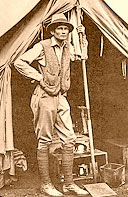|
Hiram Bingham, the American explorer who found the
ruins of Machu Picchu in 1911, wrote:
The Incas were fortunate in having as their
subjects a hard-working race, accustomed to constant effort. Today while
one encounters lazy men, one never sees Quechua women idle. While
tending flocks or walking along the road they are almost always winding
or spinning yarn. One often finds them engaged in the manufacture of
shawls, girdles, ponchos, and blankets on hand looms. Even the men and
older children are sometimes thus engaged.
As a matter of
fact, ancient Andean weaving, as developed
by the Incas, was one of the greatest
textile arts the world has ever seen. We
depend on silk worm or the flax plant. They
had cotton and the soft wool of the alpaca
but they also used the extremely fine and
rare wool of the vicuna, the smallest
American camel. They never took the trouble
to domesticate it. They depended on what
would be caught by the Inca hunters after
being rounded up in huge annual drives.
Tourists in Peru
are always anxious to secure rugs made of
vicuna skins but these little animals have
now become so scarce as to be protected. In
the days of the Incas vicuna wool seems to
have been reserved for the rulers and the
nobles.
Examples of
early Peruvian textiles amaze the beholder.
Fine specimens may be seen in various
museums of art in Boston, New York and
Washington. They are as worthy of admiration
as the finest specimens of Egyptian or
Chinese weaving. The inventiveness and
resourcefulness of the Peruvian weavers
created materials which indicate as long a
period of artistic development as that of
Egypt or China. These rare and beautiful
stuffs which have been found in the coastal
cemeteries of Peru, where they have been
preserved by the dry desert air and the
absence of rainfall, prove to the students
of the history of art the very great age of
Inca civilization. An none of it was
borrowed from Asia.
We are told that
the finest textiles were made in the
convents connected with the Temples of the
Sun, by the Chosen Women, sometime called
the Virgins of the Sun, who were carefully
trained in this difficult art. Some of their
products are as fine and soft as the finest
silk. The Lima Museum has the best examples.
Source:
‘Lost City of the Incas, The Story of Machu
Picchu and its Builders’ by Hiram Bingham
The American explorer who found the ruins of Machu Picchu in 1911.

Hiram Bingham at Machu Picchu
The inspiration for Indiana Jones?
|